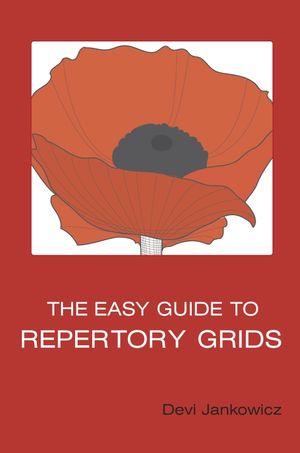The Easy Guide to Repertory GridsISBN: 978-0-470-85404-4
Paperback
330 pages
October 2003
 This is a Print-on-Demand title. It will be printed specifically to fill your order. Please allow an additional 10-15 days delivery time. The book is not returnable.
|
||||||
List of Tables.
About the Author.
Preface.
1. INTRODUCTION.
1.1 How to Use This Guidebook.
1.2 What This Book Contains.
1.3 What This Book Misses Out.
1.4 A Word About the Examples.
2. THE REPERTORY GRID: A BASIC DESCRIPTION.
2.1 The Basic Repertory Grid.
2.1.1 The Basic Constituents of a Grid.
Constructs.
Topic.
Elements.
Ratings.
2.1.2 So What is a Repertory Grid?
2.1.3 A Description of the Other Person in Their Own Terms.
2.2 An Example of a Completed Repertory Grid.
2.3 Points to Remember.
Things to Do.
Exercise 2.1 Specifying Constructs.
Exercise 2.2 Understanding the Background.
Things to Read.
3. ELICITING A REPERTORY GRID.
3.1 Grid Elicitation.
3.1.1 The Interview: Setting and Style.
3.1.2 The Basic Procedure Is in 10 Steps.
3.2 The Background to the Standard Procedure.
3.2.1 Choosing the Topic.
Tw o Rules of Thumb.
Qualifying Phrases.
3.2.2 Choosing Elements.
Elements Chosen by Investigator.
Elements Chosen by Interviewee.
Elements Chosen by Negotiation between Investigator and Interviewee.
Elicited Elements.
3.2.3 Specifying Constructs.
Laddering Down.
Qualifying Phrases as a Focus.
3.2.4 Obtaining Ratings.
3.3 Thinking About Yourself.
Things to Do.
Exercise 3.1 A First Practice Grid.
Exercise 3.2 Designing a Grid.
Exercise 3.3 A Self-Grid.
Things to Read.
4. QUESTIONS ABOUT GRID WORK.
4.1 Simple Procedural Issues: Questions and Answers.
4.1.1 Questions About the Elements.
4.1.2 Questions About the Constructs.
4.1.3 Questions About the Rating Procedure.
4.1.4 And, Overall.
4.2 Capturing Meaning by Using a Grid.
4.2.1 Triadic Elicitation.
4.2.2 The Full Context Form.
4.2.3 Dyadic Elicitation.
4.2.4 Elaboration.
4.2.5 The ‘Catch-All’ Question.
4.2.6 Alternatives to Rating.
Grouping the Elements.
Ranking the Elements.
4.2.7 Supplied Constructs.
4.2.8 Supplied Elements.
4.3 Capturing Meaning Without Using a Grid.
4.3.1 Being a Good Observer.
4.3.2 Storytelling.
Self-Characterisation.
Characterising Others.
Other Monadic Procedures.
4.3.3 Non-Verbal Techniques?
4.4 Increasing Detail and Variety.
4.4.1 Laddering Down – Asking ‘How, in What Way?’
Rating the Laddered Constructs in the Grid.
4.4.2 Pyramiding Technique.
Rating the Pyramided Constructs in the Grid.
Things to Do.
Exercise 4.1 Handling the Interview.
Exercise 4.2 Practising Pyramiding.
Things to Read.
5. DESCRIPTIVE ANALYSIS OF A SINGLE REPERTORY GRID.
5.1 An Overview.
5.2 A Stance Towards Analysis.
5.3 Describing the Basic Grid.
5.3.1 Process Analysis.
The Topic.
The Elements.
The Constructs.
The Ratings.
5.3.2 Eyeball Analysis.
5.3.3 Characterising Constructs.
Core Versus Peripheral Constructs.
Propositional Versus Constellatory Constructs.
Pre-emptive Constructs.
Other Types of Construct.
Standard Classification Schemes.
Things to Do.
Exercise 5.1 Practising Process Analysis.
Exercise 5.2 Practising Eyeball Analysis and Construct Categorisation.
Exercise 5.3 Characterising Constructs.
Things to Read.
6. ANALYSING RELATIONSHIPS WITHIN A SINGLE GRID.
6.1 Simple Relationships.
6.1.1 Simple Relationships Between Elements.
6.1.2 Simple Relationships Between Constructs.
6.1.3 Simple Relationships in Summary.
6.2 Cluster Analysis.
6.2.1 Rationale for Cluster Analysis.
6.2.2 Procedure for Interpretation of a Cluster Analysis.
Elements.
Constructs.
6.3 Principal Components Analysis.
6.3.1 Rationale for Principal Components Analysis.
Constructs and Components.
Elements and Components.
6.3.2 Procedure for Interpretation of Principal Components Analysis.
6.4 Concluding Images.
Things to Do.
Exercise 6.1 Relationships among Elements.
Exercise 6.2 A Simple Decision Task.
Exercise 6.3 Turning Element Differences into % Similarities.
Exercise 6.4 Relationships Among Constructs.
Exercise 6.5 Turning Construct Differences into % Similarities.
Exercise 6.6 Finding Your Way Round a Principal Components Analysis Plot.
Things to Read.
7. ANALYSING MORE THAN ONE GRID.
7.1 The Nature of the Problem.
7.1.1 Sample Size.
7.1.2 Research Design.
7.2 Generic Approaches to Content Analysis.
7.2.1 Bootstrapping Techniques.
The Core-Categorisation Procedure.
The Generic Content-Analysis Procedure.
Design Issues: Differential Analysis.
Reliability.
7.2.2 A Design Example.
In Conclusion.
7.2.3 Standard Category Schemes.
Bootstrapped Schemes.
Theory-Based Schemes.
Combining Bootstrapped and Theory-Based Approaches.
7.3 Honey’s Content Analysis.
7.3.1 Rationale.
7.3.2 Procedure.
7.4 In Conclusion.
Things to Do.
Exercise 7.1 Identifying Categories.
Exercise 7.2 Practising Content Analysis: D-I-Y.
Exercise 7.3 Preparing Grid Data for Honey’s Technique.
Things to Read.
8. WORKING WITH PERSONAL VALUES.
8.1 Capturing Personal Values.
8.1.1 Laddering Up to Arrive at Values.
8.1.2 The Process of Values Elicitation.
How Do I Know That I’ve Got There?
What Do I Do if I Can’t Seem to Get There?
A Reminder.
8.2 Prioritising Personal Values: Resistance-to-Change Technique.
Things to Do.
Exercise 8.1 Explore Your Own Personal Values.
Exercise 8.2 Which of Your Values Are Resistant to Change?
Exercise 8.3 Working with Value Hierarchies.
Things to Read.
9. ALTERNATIVE WAYS OF CONSTRUING.
9.1 Identifying Personal Changes in Construing.
9.1.1 Identifying Personal Change: The Simple Change Grid.
9.1.2 Identifying Personal Change: The Messy Change Grid.
9.2. Identifying Differences Between People.
9.2.1 Facilitating Mutual Exploration: Simple Partnering.
9.2.2 Entering Another Person’s World: The Exchange Grid.
9.3 In Conclusion.
Things to Do.
Exercise 9.1 A Simple Change Grid Analysis.
Exercise 9.2 Handling a More Complex Change.
Exercise 9.3 An Exchange Grid.
Things to Read.
Appendix 1. Answers to Exercises.
Appendix 2. Extracts from the Transcript of a Grid Session.
Appendix 3. Element % Similarity Scores.
Appendix 4. Construct % Similarity Scores.
Appendix 5. Extracts from the Transcript of a Resistance-to-Change Session.
Appendix 6. The Formal Content of Kelly’s Personal Construct Theory.
Appendix 7. Aide-memoire/Summary of Grid Procedures.
Glossary.
References.
Index of Names and First-named Authors.
Subject Index.



